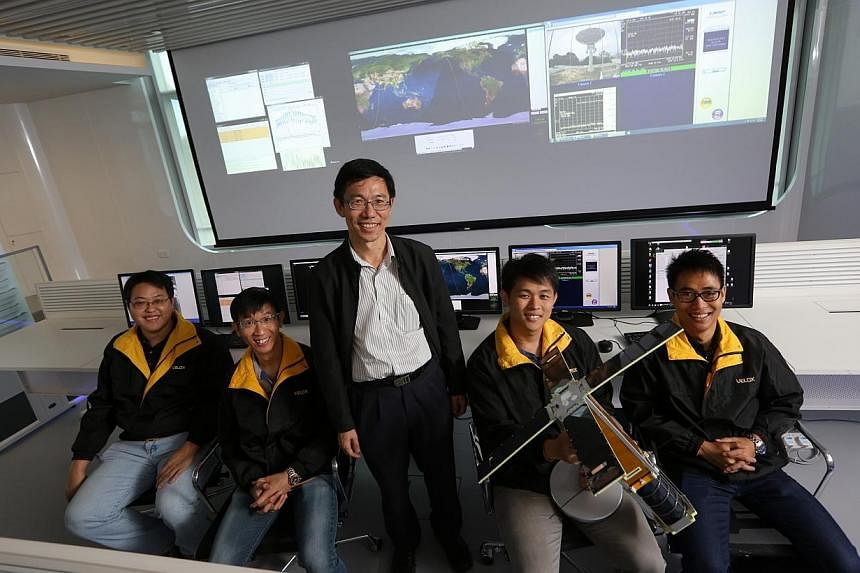SINGAPORE - It's another small step for Singapore, and one giant leap for the country's efforts in space research technology.
Locally-built satellites VELOX-I and VELOX-PIII were launched into space by a rocket from India at 12.21pm Singapore time on Monday.
VELOX-I is a 7-kg nano-satellite and VELOX-PIII will piggyback on VELOX-I as one unit, before being separated two to three months later as planned.
The satellites were designed and built by students and researchers from Nanyang Technological University (NTU) Satellite Research Centre.
Only two other countries in the region - Indonesia and Malaysia - have their own satellites in space.
We take a look at five other milestones in the development of Singapore's satellite technology.
1. ST-1, Singapore's first communications satellite, was launched in 1998.
The $398.4 million satellite is a joint venture between SingTel and Chung Hwa Telecom of Taiwan. It provided direct-to-home broadcast, Internet and telecommunications services from 1998 to 2011.
Today, it continues to provide other satellite services, such as maritime communications over areas, including India, Southeast Asia, Taiwan and southern China.
2. Singapore's first locally designed and built satellite, X-SAT, was launched into orbit in April 2011.
The 105-kg refrigerator-size X-SAT was launched into space at 12.42pm, Singapore time, on April 20, 2011, from the Satish Dhawan Space Centre in India.
It was one of three satellites riding on the Polar Satellite Launch Vehicle C16, which is owned by the Indian Space Research Organisation. The other two satellites were built by Russia and India.
X-SAT was developed by NTU and Singapore's defence research body DSO National Laboratories. More than 20 scientists and engineers had worked on the satellite for nine years.
It has helped researchers to monitor sea pollution, forest fires and other environmental changes.
3. First student-built satellite was launched in November last year.
From the classroom to outer space, a 1.33kg satellite built by a group of undergraduate engineering students from NTU was successfully launched in Russia in November last year.
The VELOX-PII is fully solar-powered and is currently used as a testbed for NTU's satellite techonology.
NTU is currently the only local university with an undergraduate satellite programme to train engineers for Singpore's space industry.
However, the National University of Singapore is also getting in on the act with its first satellite planned for launch by the end of next year.
The 50kg satellite will use hyperspectral imaging technology developed by the university's electrical and computer engineering department.
4. X-SAT successfully completes its three-year mission in April this year.
It has been battered by a radiation storm, weathered through solar storms and survived more than 30 near-collisions with debris.
But, Singapore's first micro-satellite has delivered a spectacular report card as it completes its mission this year. The satellite has travelled nearly 700 million km, taken 8,000 photographs and completed 4,400 telecommands. It has made more than 15,000 orbits, which is about four times around the Earth in a day.
Its panoramic photos include snapshots of the haze over Singapore earlier this year and the volcanic eruption of Indonesia's Mount Sinabung in February. Researchers have used them to construct 3D images to track urban changes and landslides.
The satellite will stay in orbit and continue its environmental monitoring for as long as it can.
5. By next year, there could be a total of seven locally designed and built satellites in the earth's orbit.
The space industry in Singapore is set to skyrocket in the next few years.
ST Electronics is "in the final stage of development" of the first locally made commercial satellite, the TeLEOS-1.
The 400kg satellite could be used for global disaster and environmental monitoring.
Meanwhile, NTU's tropical weather monitoring satellite, the Velox-Cl is due to be completed by September.
Both these satellites are slated to be launched from India by September next year.
Last year, the Government set up an office dedicated to researching and developing the industry here, in particular the manufacture of satellites. It also set aside funding worth $90 million.
Sources: The Straits Times Archives, Singapore Infopedia by National Library Board

